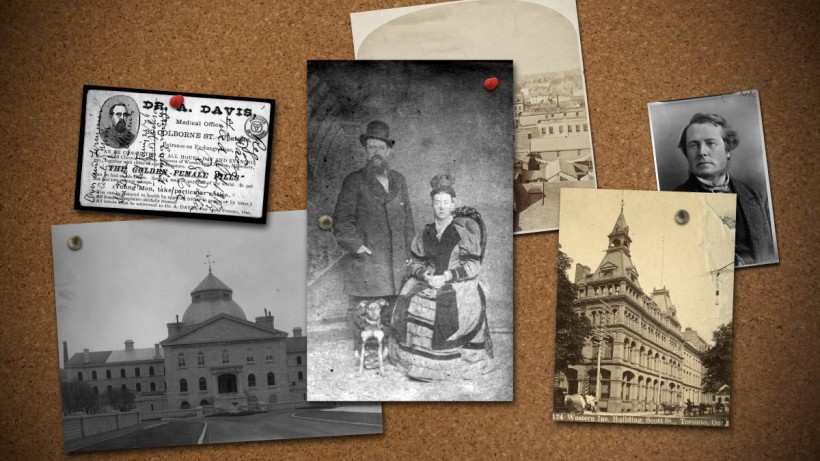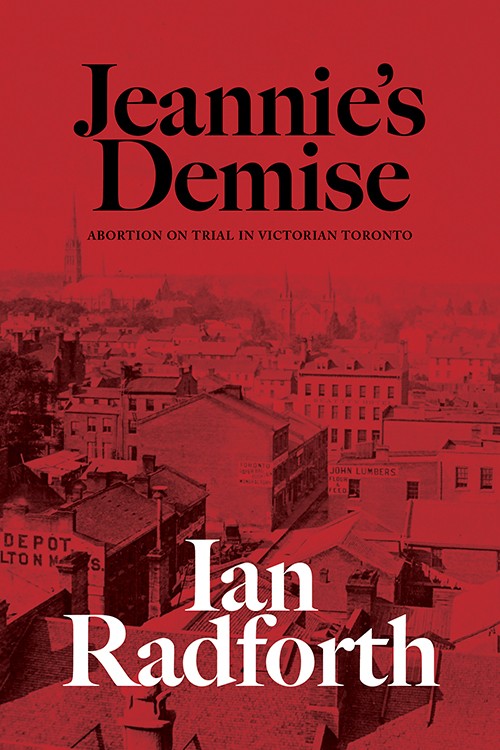An abortion gone wrong in “Toronto The Good”... in 1875

In the summer of 1875, Jeannie Gilmour, a twenty-three-year-old, single woman, horrified to discover she was pregnant, sought an abortion. Desperate, Jeannie turned to Arthur and Alice Davis, a married couple with no formal medical training who advertised in coded language that they provided abortions in a back street at the centre of Toronto. The procedure went disastrously, ending in Jeannie’s death. The abortion-providers sought to escape the reach of the law by disposing of Jeannie’s naked body under cloak of darkness in a pine box out on the edge of town. Almost immediately, the body was found and police charged the Davises with Jeannie’s murder.
Toronto’s several daily newspapers took up the sensational story and from there it traveled to many cities across Canada and the United States. It was startling that the body of an unidentified woman had been discovered naked in a box, discarded in a ditch by the side of the road. Once it had been identified as the body of Jeannie Gilmour, journalists pondered how it had been possible for young Jeannie, the respectable daughter of a Baptist minister, to be seduced and then to seek an abortion at a price far beyond her means. The Toronto press expressed surprise—or feigned surprise—that the Davises had operated their abortion practice in defiance of the law in the heart of the city. Why had police and respectable medical practitioners not closed them down? After all, the city was known as “Toronto the Good.”
The book explores the case’s various settings and fascinating characters. Readers are introduced to such places as the city’s dead-house, a dismal building near Toronto harbour where Jeannie’s decaying body was placed on display for residents to identify her; the police court, a stinking structure built above the horse barns of the fire department; and the handsome county courthouse on Adelaide Street East, now the popular Italian restaurant Terroni. Readers meet Jeannie’s father, an earnest evangelical pastor and pioneer bush farmer shocked and mystified by the demise of his well-behaved, if independent daughter; abortionist Arthur Davis, who followed his father into the family trade; and his wife Alice, a church-going farmer’s daughter from upstate New York who as Arthur’s bride quickly adjusted to living in the city and working in an abortion practice.
The press closely watched the October murder trial of Arthur and Alice Davis. The prosecution’s evidence was entirely circumstantial. After all, no witnesses had been there when the abortion took place. Furthermore, the Crown had failed to identify a seducer or the person who paid for the abortion.
The Crown’s case against the Davises focused on showing that the body was actually Jeannie Gilmour’s; that she had been seen at the Davises’ home; that blood police discovered in the home matched the blood found in the pine box with Jeannie’s body; that Arthur Davis had paid a carpenter to make the box on the day before the body’s discovery; that the Davises and another man had been seen loading the box onto a wagon; and that the wagon and box had been seen in city streets on the way to the nearby countryside. Defence attorneys chipped away at the testimony of the Crown’s witnesses, but the defence’s case was weak. After only a little deliberation, the jury found Arthur and Alice Davis guilty of murder. With a conviction for murder, the death sentence was mandatory. The trial judge sentenced the pair to death, scheduling their hangings for December.
Public opinion as expressed in the press deemed the jury’s verdict appropriate, certainly for Arthur. As for Alice, some commentators thought she should have been found not guilty because as a wife she had been bound to do her husband’s bidding. Because the Crown had the power to show mercy and reduce sentences, Alice’s supporters petitioned Ottawa for clemency. The minister of justice agonized over what to do. Behind-the-scenes negotiations produced what amounted to a deal that the politicians thought the public might find acceptable. Given that the Davises were willing to testify about their crime and identify the seducer thus allowing the law to pursue him, their sentences would be reduced to life in Kingston Penitentiary. And that’s what happened.
Jeannie’s Demise takes readers back to the county courthouse in Toronto where two related trials took place that winter. The man that Arthur Davis named as having paid for the abortion was tried for murder. Tried as an accessory after the fact was the carpenter that Alice and Arthur said had assisted them in hiding their crime by building the box and helping to dispose of the body. The book also follows the Davises inside the sombre, limestone walls of Kingston Penitentiary and discusses the repeated attempts over many years to have the convicted murderers released.
Read the book to discover why the law treated Jeannie’s death from a botched abortion as murder; to see how the press vilified the abortion-providers; and to follow the story of the Davises’ sensational reveal of the seducer, a public figure in the city.
Jeannie’s Demise illustrates the devastating price a Toronto woman could pay to end a pregnancy at a time when abortions were outlawed in Canada and providers—whatever their skills—were driven underground.
Thanks to the pro-choice movement, abortions are no longer illegal in Canada. This year marks the fiftieth anniversary of the Abortion Caravan, a convoy of feminist activists who left Vancouver for Ottawa to demand free abortion on demand. They stopped along the way to demonstrate and rally supporters to join in the trek to the capital. Their campaign was important to the eventual decriminalization of abortion.
Still, the struggle continues. Today, too many women in Canada must travel long distances and incur burdensome costs to access abortion services. In many parts of the United States rollbacks on abortion rights and restrictions on clinics are making access to safe abortion procedures ever-more difficult. A consequence of poor access to safe abortions can result in women attempting dangerous home remedies and risky procedures with resultant tragedies like the one that befell Jeannie Gilmour.

